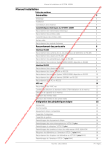Download VM41R USER MANUAL - VMI International AB
Transcript
VM41R VIBRATION MONITOR FOR MULTIPLE CHANNELS USER MANUAL Table of Contents Table of Contents ............................................................................................................................. 2 WARRANTY DISCLAIMER .............................................................................................................. 3 Introduction ....................................................................................................................................... 4 Using AC and DC measurements .......................................................................................................... 4 Functions ................................................................................................................................................... 4 Radio Shield .............................................................................................................................................. 4 Connecting transducers ................................................................................................................... 5 Description of the Channel Card VM41R-A ..................................................................................... 6 Alarm settings ........................................................................................................................................... 7 Connection diagram, each channel ....................................................................................................... 8 Description of the Channel Card VM41R-D ..................................................................................... 9 Alarm settings ......................................................................................................................................... 11 Proximity Probe adjustment .................................................................................................................. 11 Connecting transducers to VM41R-D .................................................................................................. 11 Description of the Channel Card VM41R-H ................................................................................... 12 Alarm settings ......................................................................................................................................... 14 Description of the Channel Card VM41R-T.................................................................................... 14 Alarm settings ......................................................................................................................................... 15 Mounting of vibration transducer. ................................................................................................... 16 Recommended measuring directions and transducer locations according to ISO 2372 ............... 17 Vibration standards ........................................................................................................................ 17 Floor plan for PCBs ........................................................................................................................ 18 2 WARRANTY DISCLAIMER VMI AB warrants the products to be free from defects in material and workmanship under normal use and service within two years from the date of purchase and which from our examination shall disclose to our reasonable satisfaction to be defective. Warranty claimed products shall be returned prepaid to VMI AB for service. We reserve the right to repair or to replace defective products. Always try to explain the nature of any service problem, at best by fax or letter. Check first all natural problems like broken cables etc. When returning the product, be sure to indicate that the purpose is to make repair and indicate the original date of shipment to you if possible. 3 Introduction A VM41 vibration monitoring system consists of one or a number of base frames, which can be combined together, allowing monitoring of 1 – 40 channels. Each Base frame has: ♦ Common power unit for all channels ♦ Power supply 24VDC, 110VAC and 220VAC ♦ Screw terminals for connections ♦ Channel switch ♦ Display for alarm and vibration level of selected channel Every channel has: ♦ Analysis output ♦ Current (mA) output (RMS) ♦ Independent alarm and trip relay functions ♦ Transient and voltage protection on every input and output Using AC and DC measurements Use the AC measurement for shafts, bearings, gearboxes and other rotating parts and the DC measurement for static displacement movements. Functions The channel to be displayed is selected using the channel switch on the power unit (VM41K SUPPLY in picture 1). The display, above the channel selection switch, presents the vibration level, on the selected channel, as 0-100% of selected measuring range. To specify the signal level that shall correspond to 100% signal strength: ♦ Connect a reference signal with the voltage that represents 100% of the measuring range, to the currently selected channel card. ♦ Adjust the potentiometer P1 in fig. 17 until the display on the power unit reads 100% Picture 1. Power unit (to the right) and one channel card. When the SET button is pressed, on the currently selected Channel Card, the display shows the current alarm level. The alarm level can be adjusted using a potentiometer close to the SET button. Radio Shield All the external inputs and outputs are protected against high frequencies by serial impedances and decoupling condensers. The supply power has a hum eliminator and the secondary winding of the transformer has a protection against transients. 4 Connecting transducers Picture 2. Back plane on VM41 rack. GND Vibration signal IN -24 V power to the transducer Vibration signal OUT 0/4 – 20 mA OUT Screen Screen IN+ IN+ IN- IN- AC AC mA mA GND GND -24 V power power -24 V to the the transducers, in transducers back-plane Relay 2 Normally closed Relay 1 Relay 1 is activated, when the alarm level 1 is reached. Relay 1 Relay 2 is activated, when the alarm level 2 is reached. Relay 2 GND C Normally open Fig. 1. Connectors and relays on back plane. 5 Description of the Channel Card VM41R-A 1. VM41-A (accelerometer input) has a 4 mA current generator at maximum 20VDC. Input sensitivity is selectable between 10, 25 and 100mV/g, controlled by switch S1. The VM41RA is factory set with S1 in the range 10 mm/s. The input amplifier is combined with a second amplifier, converting the signal value from acceleration to velocity. The input marked IN+ on the back panel is the signal input from the accelerometer and also the output for the 4mA current used to drive the internal accelerometer amplifier. The input marked INis the return signal input from the accelerometer and also GND. The input marked SCREEN is the same input as GND and can be used for a cable shielding. See also fig.4. Note that the cable shield should be connected in one end only. 2. With the switch S2 in position LF the conversion works down to 1.5Hz and with the switch in position HF down to 10Hz. By default, unless otherwise is specified in the order, the VM41R-A is factory set with S2 in position HF. The accelerometer signal can be accessed at the AC output (BNC) and at the screw terminal marked with AC. The signal is the same as IN+, but buffered at this output. 3. A mean value of the signal (true RMS) is then created. This signal is available as a DC current selectable between 0-20 mA with the switch S7 in position 0 mA and 4-20 mA with the switch in position 4mA. Maximum output voltage is 15 Volt at 750 ohm. The VM41R-A is factory set to 4-20 mA. This signal is suitable for an external panel instrument or a process logging system. 4. The RMS mean value signal is also used as input to two independent sets of alarm comparators. If the RMS level is higher than the alarm value set by one of the independent potentiometers, the comparator will turn on the front indicator lamp and at the same time a preset delay circuit is triggered. If the RMS level is above the alarm level during the whole delay time, the alarm relay is activated. The delay time is set by the switches S3 and S4. If they are set to position 0, the delay may be between 0 and 70 s. If they are set to position 8, he delay may be between 8 and 90 s. 5. The delay time is independently set by the two potentiometers P4 and P5 on the channel card, within the limits specified by switches S3 and S4. The VM41R-A is factory set with the potentiometers P4 and P5 to min. delay time. 0/8 sec. 25/30 sec. 70/90 sec. 45/60 sec. Fig.2. Approximate time delay setting 6 6. With the switches S5 and S6 on the channel card, it is possible to select if the relay coil is energized below or above the alarm limit. With the switch in position B the coil is energized if the vibration is below the alarm limit. This position also means that a power failure to the VM41R-A gives a change in the relay output. The VM41R-A is factory set with the switches S5 and S6 in position A. Rotation of the potentiometers P4 and P5 clockwise will increase the delay time. 7. Below the alarm level (relay not activated), the two upper screw terminals are closed. When the relay is activated, the two lower terminals are closed. Each channel card has separate relays. A relay is activated if the vibration level on one or on the both channels is higher than the specified alarm level. The relay switching capacity is 250 VAC 3 Amp closed, 250 VAC 5 Amp open. Alarm settings By pressing the SET button, you display the alarm level, in mm/s, for the currently selected channel card. The alarm level can be adjusted with the potentiometer close to the SET button, which must be pressed simultaneously (see fig.3). Proper alarm levels can be found in fig.12. H2 SET H1 SET Fig.3. Controls for Alarm settings on front panel, on channel card. 7 Connection diagram, each channel SCREEN Vibration Transducer IN+ INAC mA GND 3 RELAY2 2 1 3 RELAY1 2 1 Fig.4. Connectors and relays at the back panel, for each channel card. Relay connection: Below the alarm level (relay not activated): Terminals 2 and 3 (upper) are short circuited. Above the alarm level (relay is activated): Terminals 1 and 2 (lower) are short circuited. Note that the numbers to the right of the relays are not printed on the board. 8 Description of the Channel Card VM41R-D 1. The channel card VM41R-D has a 24VDC output on terminal IN- for the power supply of eddy current proximity probe. The terminal SCREEN function as 0 Volt and GND for both 24VDC and the output signal from the proximity probe. 2. The output signal from the proximity probe to terminal IN+ is an AC signal, with a DCcomponent. The AC or DC signal is selected using the switches S2 and S11, and is also available on the BNC connector on the front panel and terminals, on the back plane. The ANALYSIS (AC) output sensitivity is 2.8 V/mm, which means that the Peak Detector outputs a level of 2.8 VDC corresponding to current of 20mA and a signal level on the ANALYSIS (AC) output of 2.8 V Peak, for a motion of 1 mm. 3. This signal is then amplified with a range amplifier in 3 selectable preset ranges; 0.1, 0.25 and 1.0 mm, with the switch S1. The VM41R-D is factory set with S1 in the range 1.0 mm. 4. The Peak value of the signal is then calculated. This signal is available as a DC current selectable between 0-20 mA with the switch S7 in position 0 and 4-20 mA with the switch S7 in position 4. Maximum output voltage is 15 Volt. The VM41R-D is factory set to 4-20 mA. This signal is suitable as input to an external panel instrument, or a process logging system. 5. The peak value is also input to two independent sets of alarm comparators. If the level is higher than the alarm value set by one of the independent potentiometers H1 and H2 on the front panel, the comparator will turn on the front indicator lamp and at the same time a preset delay circuit is triggered. If the level is above the alarm level during the whole delay time then the alarm relay is activated. 6. The delay time is independently set by the two potentiometers P4 and P5 between 0-70 s or 8-80 s, depending on the position of the switches S3 and S4. The VM41R-D is factory set with S3 and S4 in position 8 and with the potentiometers P4 and P5 to min delay time. Approximate time delay settings are as described in fig. 2. 7. With the switches S5 and S6 it is possible to select if the relay coil is energized below or above the alarm limit. With the switch in position B, the coil is energized if the vibration is below the alarm limit. This position also means that a power failure to the VM41R-D causes a change in the relay output. The VM41R-D is factory set with the switches in position A. Rotation of the potentiometers P4 and P5 clockwise will increase the delay time. 8. The relay position marked at the terminals on the back plane is with the switch in position A and with the vibration signal below the alarm limit. The relay switching capacity is 250 VAC 5 Amp. 9 DC/AC Set/AC selection: S2 and S11 Delay time adjustment for Relay 2 Delay range Relay 2 Contact for P8. Measurement range S1: D1 100µm D2 250µm (here) D3 1000µm Relay 2 activated A(bove) or B(elow) the alarm level Actual placement of potentiometer P8 Delay time adjustment for Relay 1 Delay range Relay 1 Constant current range 0-20mA or 4-20mA Relay 1 activated A(bove) or B(elow) the alarm level Picture 3. VM41R-D Channel Card. PEAK CONVERTER Fig.5. Schematic diagram of VM41R-D Channel Card. 10 Alarm settings By pressing the SET button on the front panel, you display the alarm level, in mm/s, for the currently selected channel card. The alarm level can be adjusted with the potentiometer close to the SET button, which must be pressed simultaneously (see fig.3). Proper alarm levels can be found in fig. 12. Proximity Probe adjustment 1. The VM41R-D is factory adjusted for a distance of 5 mm between object and probe. 2. Set the switches S2 and S11 in position DC and select this channel card with the switch on the power supply unit. 3. Connect the proximity probe and adjust the distance until the reading on the display is close to zero (±20%). Tighten the nuts on the proximity probe and adjust the potentiometer marked ZERO, on the front panel, until the display reads zero. 4. Select the desired signal AC or DC with the switches S2 and S11. The AC signal contains only the information of the alternating motion of the object. The DC signal contains both the information of the alternating motion of the object and the static change in distance from the original zero setting. 5. Select the proper measuring range with the switch S1. When the switch S1 is in position: − D3: 100% on the display equals 1.00 mm − D2: 100% on the display equals 0.25 mm − D1: 100% on the display equals 0.10 mm Connecting transducers to VM41R-D A schematic description of how different transducers are connected to a VM41R-D card can be found in fig. 6 and fig.7. Fig.6. Connecting Proximity Probe. 11 Fig.7. Connecting Pulse Transducer Description of the Channel Card VM41R-H 1. VM41R-H has a balanced input amplifier, with a low pass filter at 2000Hz (3dB point) for the standard-model and at 1000Hz for the ISO-model, followed by a linearization circuit, used in conjunction with the velocity transducers HG91 supplied by VMI AB. The input amplifier has a Common Mode Rejection Ratio of 60dB. This means that signals that enter the amplifier in phase on both input leads are rejected. If VM41R-H is part of a system where phase measurement is performed, the transducer polarity is important. The red cable on the transducer HG91 must be connected to the terminal marked IN+ and the white cable to the terminal marked IN-. The SCREEN input can be used for connection of the cable shield; note that the shield should be connected in one end only. The cable to the transducer HG91 is not shielded. 2. The linearization circuit transforms the output from the velocity transducer into a linear signal, both regarding magnitude and phase. With the switch S2 in position LF the linearization works down to 1.5 Hz and with the switch S2 in position HF the linearization works down to 10 Hz. Unless otherwise is specified in the order, the VM41R-H is factory set with S2 in position HF. This signal is available for further analysis by frequency analyzers and similar instruments, both at the terminals and at the front BNC connector. Signal sensitivity is 10 mV/(mm/s). The linearized signal is further low pass filtered at 2000 Hz as standard and at 1000Hz on the ISO model according to ISO 2372 standard. 12 3. The resulting signal is then amplified with a range amplifier in 3 selectable preset ranges: 10, 25 and 100 mm/s, controlled by the switch S1. The VM41R-H is factory set with S1 in the range 10 mm/s. 4. A mean value of the signal (true RMS) is then created. This signal is available as a DC current, selectable between 0-20 mA with the switch S7 in position 0 and 4-20 mA with the switch S7 in position 4. Maximum output voltage is 15 Volt. The VM41R-H is factory set to the 4-20 mA range. This signal is suitable as input to an external panel instrument, or a process logging system. 5. The RMS mean value signal is also input to two independent sets of alarm comparators. If the RMS level is higher than the alarm value set by one of the independent potentiometers, the comparator will turn on the front indicator lamp, and at the same time a preset delay circuit is triggered. If the RMS level is above the alarm level during the whole delay time, the alarm relay is activated. 6. The delay time is independently set by the two potentiometers P4 and P5 between 0 - 70 s or 8 - 80 s depending on the position of the switches S3 and S4, which can be set in either position 0 (0 - 70 s) or position 8 (8 - 80 s). Unless otherwise is specified, the VM41R-H is factory set with S3 and S4 in position 8 and with the potentiometers P4 and P5 to min delay time. 7. With the switches S5 and S6 it is possible to select if the relay coil is energized below or above the alarm limit. With the switch in position B the coil is energized if the vibration is below the alarm limit. This position also means that a power failure to the VM41R-H gives a change in the relay output. The VM41R-H is factory set with the switch in position A. Rotation of the potentiometers P4 and P5 clockwise will increase the delay time. 8. The relay position marked at the terminals on the back plane is with the switch in position A and with the vibration signal below the alarm limit. The relay max switching capacity is 250 VAC 5 Amp. ”RMS” card Measurement range S1: D1 10 mm/s D2 25 mm/s D3 100 mm/s Delay range Relay 2 Delay time adjustment for Relay 2 Uppermost pin on Q1 Relay 2 activated A(bove) or B(elow) the alarm level Delay time adjustment for Relay 1 Delay range Relay 1 Constant current range 0-20mA or 4-20mA Relay 1 activated A(bove) or B(elow) the alarm level Picture 4. VM41R-H Channel Card 13 The cable between the transducer junction box and the VM41R-H can be any 2-leader cable with a 2 common shield. The copper area should be equal to or greater than 0.22 mm . The cable length should not exceed 1000 m with the minimum copper area. Alarm settings By pressing the SET button on the front panel, you display the alarm level, in mm/s, for the currently selected channel card. The alarm level can be adjusted with the potentiometer close to the SET button, which must be pressed simultaneously (see fig.3). Proper alarm levels can be found in fig. 12. Description of the Channel Card VM41R-T 1. VM41R-T is equipped with a Signal Conditioner for a PT-100 element, for temperature measurement, mounted in socket U1. The input to the signal conditioner is a PT-100 three- or twowire connection, where one side of the transducer must be connected to terminal IN- on the back plane, and the other side to terminals IN+ and AC (three-wire) or to IN+, with a short circuit between IN+ and AC (two-wire). SCREEN SCREEN IN+ IN+ PT-100 Transducer IN- AC AC mA GND PT-100 Transducer IN- Three-wire connection mA GND Two-wire connection Fig. 8. Connecting PT-100 Temperature Transducer 2. The output from the Signal Conditioner is a DC level between 0 and 2.5 V, where the voltage is proportional to the measured temperature. The sensitivity is pre-set by VMI, using two potentiometers on the Signal Conditioner board. 3. The signal representing the temperature is also available at the mA terminal, at the back plane, as a DC current. It is selectable between 0-20 mA with the switch S7 in position 0 and 4-20 mA with the switch S7 in position 4. Maximum output voltage is 15 Volt. The VM41R-T is factory set to the 4-20 mA range. This signal is suitable as input to an external panel instrument, or a process logging system. 4. The DC signal is input to two independent sets of alarm comparators. If the DC level is higher than the alarm value set by one of the independent potentiometers, the comparator will turn on the front indicator lamp and at the same time a preset delay circuit is triggered. If the DC level is above the alarm level during the whole delay time, the alarm relay is activated. 5. The delay time is independently set by the two potentiometers P4 and P5 between 0 - 70 s or 8 80 s depending on the position of the switches S3 and S4, which can be set in either position 0 (0 - 70 s) or position 8 (8 - 80 s). Unless otherwise is specified, the VM41R-T is factory set with S3 and S4 in position 8 and with the potentiometers P4 and P5 to min delay time. 6. With the switches S5 and S6 it is possible to select if the relay coil is energized below or above the alarm limit. With the switch in position B the coil is energized if the vibration is below the alarm limit. This position also means that a power failure to the VM41R-T gives a change in the relay output. The VM41R-T is factory set with the switch in position A. 14 Rotation of the potentiometers P4 and P5 clockwise will increase the delay time. 7. The relay position marked at the terminals on the back plane is with the switch in position A and with the vibration signal below the alarm limit. The relay max switching capacity is 250 VAC 5 Amp. Socket U1, for PT-100 Signal Conditioner Delay time adjustment for Relay 2 Delay range Relay 2 Relay 2 activated A(bove) or B(elow) the alarm level Delay time adjustment for Relay 1 Delay range Relay 1 Constant current range 0-20mA or 4-20mA Relay 1 activated A(bove) or B(elow) the alarm level Picture 5. VM41R-T Channel Card Alarm settings By pressing the SET button on the front panel, you display the alarm level, for the currently selected channel card. The alarm level can be adjusted with the potentiometer close to the SET button, which must be pressed simultaneously (see fig.3). 15 Mounting of vibration transducer. A Vibration Transducer is a signal source to monitoring system and a correct mounting of the transducer is very important. The importance of correct mounting increases when higher frequencies are measured. Fig. 9. Mounting fault 1. Drill and thread a M6 hole for the stud. The hole must have at least a depth of 10 mm, because the stud protrudes 7mm from the bottom surface of the transducer. The hole must be drilled transversely to the measuring surface to avoid mounting fault according to the picture. This fault gives to low measured vibration level at frequencies over approximately 200 Hz. Fig. 10. Mounting fault 2. In this example, the threaded hole is not deep enough and the bottom surface of transducer doesn’t have proper contact with the machine. This fault gives to low measured vibration level at frequencies over approximately 800 Hz. Tighten the transducer with a hexagon spanner, width 25 mm. Maximum moment 50 Nm. Note: Do not pull or loosen the transducer at the cable gland. This may destroy the transducer permanently. 16 Recommended measuring directions and transducer locations according to ISO 2372 Measure on or as close to the bearings as possible. Measure vertically and horizontally in a direction that point to the shaft centre. Measure axially in the same height as the shaft centre. Do not measure on thin sheet metal plates. Fig.11. Recommended measuring strategy. Vibration standards Class 1: Small machines up to 15 kW Class 2: Medium size machines between 15 - 75 kW without special foundations and machines up to 300 kW on special foundations. Class 3: Large machines mounted on heavy foundations which are stiff in the measuring direction. Class 4: Large machines mounted on soft foundations which are weak in the measuring direction. This is the grade normally used for all machinery. Fig.12. Vibration standards, extraction from ISO 2372 17 Floor plan for PCBs Fig.13.Floor plan for VM41R-A Channel Card. Fig. 14 Floor plan for VM41R-D Channel Card. 18 Fig. 15 Floor plan for VM41R-H Channel Card Fig. 16 Floor plan for VM41R-T Channel Card 19 Short-circuit the two right pins, for 230 -240 VAC supply. Adjustable potentiometer Short-circuit the two left pins, for 24 VDC supply. Fig. 17. Floor plan for Power Unit Board. 20






























